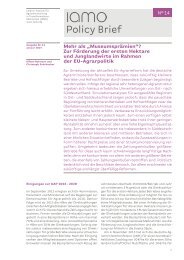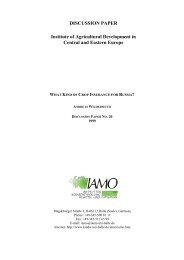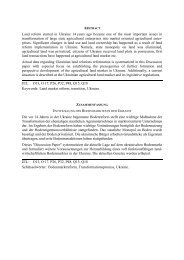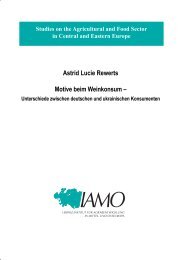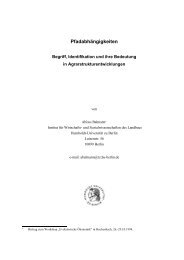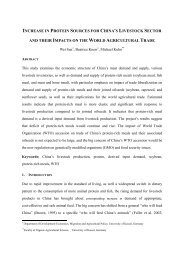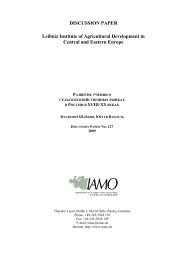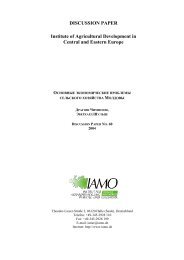the effect of bioenergy production for the agricultural outputs ... - IAMO
the effect of bioenergy production for the agricultural outputs ... - IAMO
the effect of bioenergy production for the agricultural outputs ... - IAMO
You also want an ePaper? Increase the reach of your titles
YUMPU automatically turns print PDFs into web optimized ePapers that Google loves.
2<br />
Contributed Paper presented at <strong>IAMO</strong> Forum 2008<br />
Hungary has excellent natural conditions <strong>of</strong> growing biomass. The annual sun hours are<br />
between 1700 - 2400 hours yearly. The amount <strong>of</strong> raining is between 800 - 450 mm. More<br />
than 50% <strong>of</strong> <strong>the</strong> territory <strong>of</strong> Hungary is tillage; <strong>the</strong> rate <strong>of</strong> <strong>the</strong> fields which are used by <strong>the</strong><br />
agriculture is more than 70%. The necessary plants <strong>for</strong> <strong>the</strong> <strong>bioenergy</strong> industry can give high<br />
produce because <strong>of</strong> <strong>the</strong> geographical situation.<br />
60<br />
50<br />
40<br />
30<br />
20<br />
10<br />
0<br />
Biomass potential in Hungary [PJ]<br />
58<br />
31<br />
36<br />
Potentially usable<br />
Currently<br />
harnessed<br />
Energy crops<br />
1. figure: Biomass potential in Hungary [source: Pr<strong>of</strong>. Kovacs K. MTA]<br />
Hungary has not used its opportunities in <strong>the</strong> sector <strong>of</strong> biomass as you can see on <strong>the</strong> 1 st<br />
figure. With <strong>the</strong> help <strong>of</strong> growing energy plants <strong>the</strong> potentially output energy could be <strong>the</strong><br />
double. Because <strong>of</strong> <strong>the</strong> getting stronger directives <strong>of</strong> <strong>the</strong> European Union (2003/30/EC<br />
bi<strong>of</strong>uels and 2001/77/EC “green power”) we have <strong>the</strong> consequence that <strong>the</strong> biomass<br />
<strong>production</strong> <strong>of</strong> Hungary will extremely grow in <strong>the</strong> next few years. The <strong>outputs</strong> <strong>of</strong> <strong>the</strong><br />
Hungarian agriculture will also change.<br />
1. PRODUCTION OF BIOETHANOL IN HUNGARY<br />
The national oil company <strong>of</strong> Hungary (MOL) have mixed 4.4 cubic % bioethanol to <strong>the</strong><br />
traditional petrol since 1 st July 2007. 88 thousand litres (70 thousand tons) bioethanol is<br />
mixed into 1.5 million tons (2 billion litres) petrol. [Popp] According to <strong>the</strong> 2003/96/EC<br />
energy taxation directive Hungary uses 103.5 Ft (1 € ≈ 260 Ft) tax refund pro <strong>the</strong> litre <strong>of</strong><br />
circulated bioethanol.<br />
Bioethanol is produced principally from maize and small amount (only <strong>for</strong> experiments) from<br />
sugar beet and from potato in Hungary. Accordingly <strong>the</strong> most affected <strong>agricultural</strong> output is<br />
<strong>the</strong> maize growing.<br />
The bioethanol <strong>production</strong> from sugar beet would be wanted in Hungary because only one<br />
sugar factory is working from <strong>the</strong> 12 ones that were working through centuries. Consequently<br />
Hungary has only <strong>the</strong> quarter <strong>of</strong> <strong>the</strong> <strong>for</strong>mer more than 100 thousand hectare sugar beet



